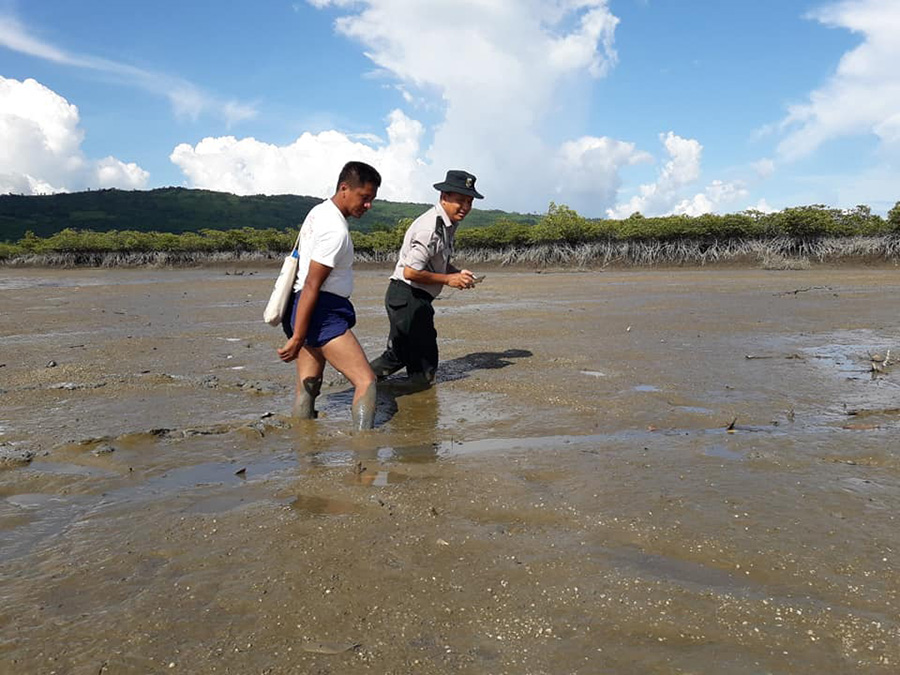YANGON – Nearly 170 villagers contracted a skin disease after collecting some of the thousands of dead marine mussels that have mysteriously washed up in inlets of the Thanzit River in southern Rakhine State’s Kyaukphyu Township in recent days.
Five villagers were treated at Kyaukphyu General Hospital on Sunday.
A hospital employee confirmed that five patients from Kyauk Ngu Village arrived at the hospital at 4:20 p.m. on Sunday and were tested by a doctor. Staff were unable to name the specific disease the villagers had or the medication they were given. The employee believed the patients had complained of skin irritation.
“We saw bumps on their hands and bodies. Doctors assumed it was a normal skin allergy,” the employee said.
The Irrawaddy attempted to contact Kyaukphyu General Hospital superintendent Dr. Nay Lin and other doctors at the hospital on Monday but the phone calls were rejected.
One person on the medical staff said five patients came to the hospital seeking medical treatment.

Ko Myo Lwin, founder of Ann Regional China Pipeline Watch (ARCPW), said the group has documented a total of 167 locals in Kyauk Ngu village who have been infected with a mysterious skin disease after returning from mussel catching sites. The group stumbled upon the first cases in July while making assessments for a separate project in five townships, including Kyaukphyu.
Kyauk Ngu villager Ko Maung Gyi told The Irrawaddy over the phone that five women were going to see a doctor at Kyaukphyu Hospital. According to him, all five patients were women. They hadn’t returned to the village as of Monday evening.
“Dozens of villagers have the same type of red spots on their skin and some said it was very itchy… and we have never experienced this before. This is the very first time,” Ko Maung Gyi said.
ARCPW reported the skin disease problem of Kyauk Ngu villagers to Chief Minister U Nyi Pu in the Rakhine capital, Sittwe, on Sept. 17. The group suggested examining the five infected villagers as an initial step. Ko Myo Lwin said state cabinet members told him the state authorities would try their best to get to the bottom of the peculiar outbreak. However, a hospital employee said he had received no such complaint from either local authorities or villagers.
In fact, ARCPW has been observing mussel harvesting sites since July and found a huge site with many dead mussels near Laung Chaung village, more than 25 kilometers from Maday Island, where a pipeline project owned by the Chinese state-run China National Petroleum Corp. (CNPC) is situated. The company owns a jetty for international oil tankers and normally pumps oil from the vessels to oil tanks on the island. It annually transmits up to 22 million tons of crude oil from Maday Island to China’s Yunan Province.
Kyaukphyu residents and some activists posted photos of the dead mussels on Facebook over the weekend. The photos quickly drew a lot of public attention. Some netizens speculated the problem was caused by the contamination of seawater as Chinese oil tanker crews dumped oil into the river while cleaning the ship. The state-owned Myanmar Oil and Gas Enterprise (MOGE) previously rebutted the accusation without elaborating on laboratory examination results.
Later, the Yangon-based environmental group Ecology and Economic Development Company Limited (ECODEV) announced it had discovered that lead concentration in the Thanzit River was potentially high and urged the government to investigate the root cause.
On Monday, Ko Myo Lwin and some environmentalists traveled by boat to the incident sites in order to identify the cause of the mussel deaths, leaving in the morning and arriving at around 2 p.m. Local authorities could not be reached for comment Monday. It was unclear whether the shellfish were killed by deadly chemicals or because of contaminated seawater, or if it was a sign that their life cycle in the river was ending.
“The dead mussels covered nearly 1 acre of low tide river area,” Ko Myo Lwin said from the spot on Monday.
Another participant, schoolteacher U Tun Lwin from Kyaukphyu, told The Irrawaddy they took empty mussel shells and water samples from the site to send to a Yangon laboratory for scientific examination.

















